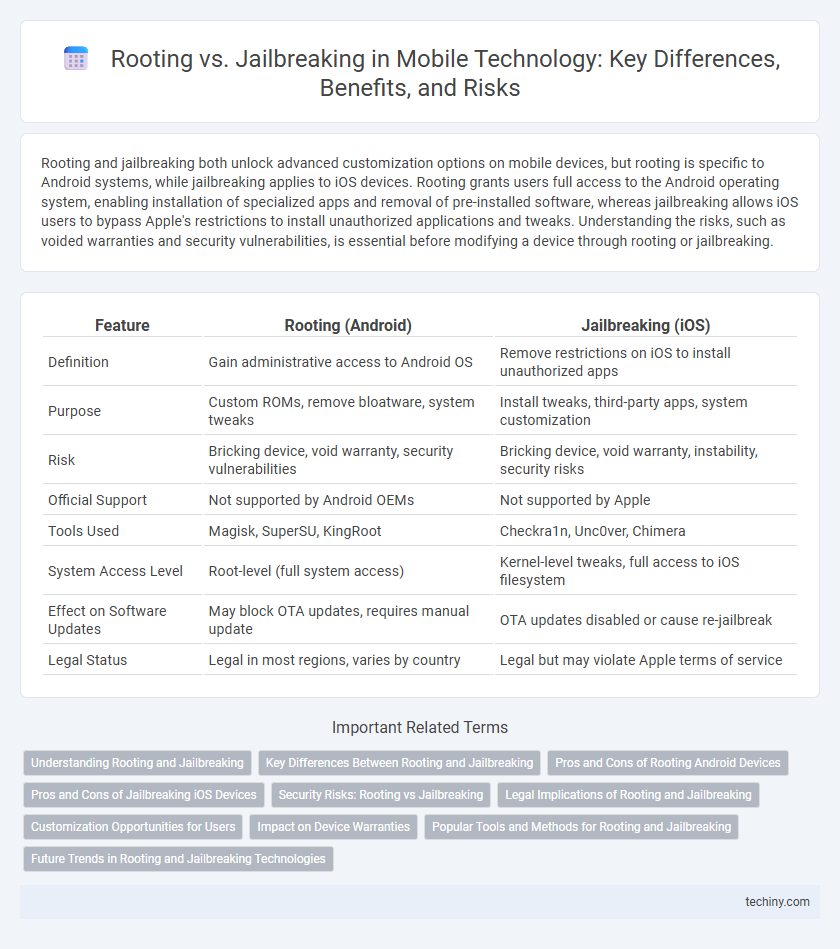Rooting and jailbreaking both unlock advanced customization options on mobile devices, but rooting is specific to Android systems, while jailbreaking applies to iOS devices. Rooting grants users full access to the Android operating system, enabling installation of specialized apps and removal of pre-installed software, whereas jailbreaking allows iOS users to bypass Apple's restrictions to install unauthorized applications and tweaks. Understanding the risks, such as voided warranties and security vulnerabilities, is essential before modifying a device through rooting or jailbreaking.
Table of Comparison
| Feature | Rooting (Android) | Jailbreaking (iOS) |
|---|---|---|
| Definition | Gain administrative access to Android OS | Remove restrictions on iOS to install unauthorized apps |
| Purpose | Custom ROMs, remove bloatware, system tweaks | Install tweaks, third-party apps, system customization |
| Risk | Bricking device, void warranty, security vulnerabilities | Bricking device, void warranty, instability, security risks |
| Official Support | Not supported by Android OEMs | Not supported by Apple |
| Tools Used | Magisk, SuperSU, KingRoot | Checkra1n, Unc0ver, Chimera |
| System Access Level | Root-level (full system access) | Kernel-level tweaks, full access to iOS filesystem |
| Effect on Software Updates | May block OTA updates, requires manual update | OTA updates disabled or cause re-jailbreak |
| Legal Status | Legal in most regions, varies by country | Legal but may violate Apple terms of service |
Understanding Rooting and Jailbreaking
Rooting and jailbreaking are processes that unlock deeper access to a mobile device's operating system, with rooting typically associated with Android devices and jailbreaking related to iOS devices. Rooting grants users administrative privileges to modify system files and settings, enabling customization and installation of unauthorized apps, while jailbreaking removes Apple's restrictions to allow similar freedoms on iPhones and iPads. Both methods expose devices to security risks and may void warranties but offer enhanced control and flexibility for advanced users.
Key Differences Between Rooting and Jailbreaking
Rooting refers to gaining administrative access on Android devices, allowing users to modify system files and install unauthorized apps, while jailbreaking applies to iOS devices to bypass Apple's restrictions and customize the operating system. Rooting often involves unlocking the bootloader and flashing custom ROMs, whereas jailbreaking exploits vulnerabilities to remove software limitations without altering the hardware. Security risks differ; rooting may void warranties and expose devices to malware, whereas jailbreaking increases exposure to unauthorized app sources and potential data breaches.
Pros and Cons of Rooting Android Devices
Rooting Android devices grants users full administrative control, enabling customization, removal of bloatware, and access to advanced apps, which significantly enhances device functionality. However, rooting poses risks such as voiding manufacturer warranties, increased vulnerability to malware, and potential system instability if not executed correctly. Users must weigh the benefits of deeper system access against security concerns and possible damage to the device's software integrity.
Pros and Cons of Jailbreaking iOS Devices
Jailbreaking iOS devices allows users to install unauthorized apps and customize the operating system beyond Apple's restrictions, offering enhanced control and access to a broader range of features. However, it compromises device security, can void warranties, and may lead to system instability or frequent crashes. Users should weigh the benefits of increased customization against the risks of malware exposure and potential loss of official support.
Security Risks: Rooting vs Jailbreaking
Rooting Android devices and jailbreaking iOS devices both expose users to significant security risks by bypassing built-in operating system restrictions designed to protect against malware and unauthorized access. Rooting increases vulnerability to malicious apps, data breaches, and system instability due to extensive access privileges, while jailbreaking similarly compromises iOS's secure boot chain and sandbox environment, facilitating potential exploits. Both processes undermine the device's native security architecture, making regular updates and trusted app sources critical to mitigating potential threats.
Legal Implications of Rooting and Jailbreaking
Rooting Android devices and jailbreaking iPhones both involve bypassing manufacturer restrictions, but legal implications vary by country and jurisdiction. In the United States, rooting and jailbreaking are generally legal under the Digital Millennium Copyright Act (DMCA) exemptions, but using these methods to install pirated apps or violate terms of service may lead to legal consequences. Users should carefully review local laws and carrier policies, as unauthorized modifications can void warranties and impact device security compliance.
Customization Opportunities for Users
Rooting on Android devices and jailbreaking on iOS unlock extensive customization opportunities beyond manufacturer restrictions, allowing users to install specialized apps, modify system files, and enhance performance. Root access facilitates deeper control over hardware settings and software adjustments, while jailbreaking enables the installation of third-party app stores and tweaks unavailable through the Apple App Store. Both processes expand personalization capabilities, offering tailored user experiences and functionality enhancements not achievable on stock devices.
Impact on Device Warranties
Rooting an Android device or jailbreaking an iOS device typically voids the manufacturer's warranty due to unauthorized modifications to the operating system. Device manufacturers strictly monitor these actions as they compromise security protocols and system integrity, leading to refusal of warranty service or repairs. Users risk losing official support and may encounter difficulties in receiving software updates or technical assistance after performing these procedures.
Popular Tools and Methods for Rooting and Jailbreaking
Popular tools for rooting Android devices include Magisk and KingRoot, which enable users to gain privileged control over the operating system by modifying system files. Jailbreaking iOS devices commonly involves tools like unc0ver and Checkra1n, which exploit vulnerabilities to remove Apple's software restrictions and allow installation of unauthorized apps. Both rooting and jailbreaking methods require specific versions of the device firmware and carry risks such as voiding warranties and potential security vulnerabilities.
Future Trends in Rooting and Jailbreaking Technologies
Future trends in rooting and jailbreaking technologies emphasize enhanced security bypass methods and deeper system access while maintaining device stability. Advances in AI-driven exploitation techniques are expected to automate the process, making it more accessible yet sophisticated. Mobile OS developers will increasingly deploy advanced detection algorithms and sandboxing methods to counteract unauthorized modifications.
Rooting vs Jailbreaking Infographic

 techiny.com
techiny.com